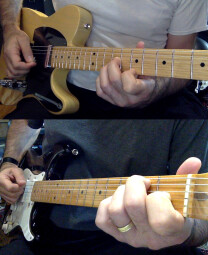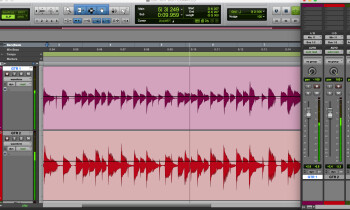Whenever you have more than one guitarist playing chords in a song, you risk a cluttered and muddy sounding result if the parts they’re playing are not coordinated in advance. That said, there are pretty big differences in the approach you’ll take to rhythm-guitar arranging, depending on whether you’re arranging for the stage or studio. In this article we’ll look at strategies for successfully arranging your rhythm parts for both scenarios.
Stage

No matter what the musical style, you generally want to avoid having two guitarists just strumming chords simultaneously, unless you’ve worked out their parts in advance. There are two reasons for this, the first that you probably want to keep them out of the same range to avoid muddying up the sound. And here lies the biggest difference with studio rhythm parts. When recording, you have the ability to pan guitar parts to give them separation from each other in the mix. That’s why big thick, stereo doubled guitar parts work so well on recordings. They’re occupying different parts of the stereo image, and thus not getting in each other’s way.
Onstage, you don’t have such a defined left to right image. Yes, you can set your guitarists up on either side of the stage, but by the time the sound gets done bouncing around the venue, that separation is likely to be diminished, and if the amps are miked and the PA is mono (which will often be the case), those parts will be pushed together in the mix that much of the audience hears.
So for live guitar arrangements, it’s often best to create separation via frequency, rather than stereo placement. And that usually means, having the guitarists playing in different registers. If one is playing chords low on the neck that are based on the bottom three strings, the other could be playing different inversions higher up the neck, so that they create an interlocking sound that’s not doubling any, or at least, not many notes.
The other way to create separation is rhythmically. If both are playing different rhythms, their parts are less likely to step on each other. For instance, you could have one guitarist strumming and the other playing arpeggios. Or if it’s a funky song, one could be playing muted one-note, rhythmic riffs while the other is playing high chordal parts.
In some types of rock, especially the heavier genres, you’re going to have songs where you do want both playing the same type of part in the same register. If that’s the case, the only way to avoid muddiness is to make sure they’re as locked together rhythmically as possible. Possibly one could be tuned down a step or two and the other in standard tuning to help differentiate the sound a little. In some instances, the difference in tone between the two guitar rigs may be sufficient, as long as the players are doubling exactly.
The point of all this advice is to point out that you should always be aware of how each player’s part is affecting the overall sound. If you have a keyboardist who is also playing chords, you’ll have to factor that in, too, although its tonal differences will make that easier.
When you’re working out arrangements in rehearsal, guitarists should play through their parts together without the rest of the instruments to see how they sound together and how they’re locking in. Add the keyboard, if there is one, and check again. Are they all working together or are they fighting each other from a frequency, or rhythmic standpoint? Also check them with all instruments playing but without the vocals.
Studio
As mentioned, you have a lot more freedom with rhythm guitar arrangements for recording. You can double parts easily and pan them for separation. You can stack parts on the same sides and use EQ to carve out spaces for them. Or you can move some of the parts about halfway in towards the center, leaving others all the way left and right. Check out this article to read more about specific doubling techniques.

But although you don’t have to worry as much about muddiness from doubled parts, you still should be thinking about frequency and rhythm if you’re going to be adding parts beyond just doubling up power chords.
Like when you’re playing live, combining different types of parts that interlock can be very effective. Sometimes a different sound can help with separation. If you’re doubling power chords, it’s sometimes useful to try recording one of the parts using a different guitar, or different amp, or different pickup setting, or a different tuning, as mentioned before, to change the timbre a little.
Recording an acoustic rhythm track to supplement electric parts can work really well to give a rootsy flavor to a song. If the electrics are hard left and right, the acoustic can sound good panned close to the center in such an instance, although, of course, it depends on the song and the other elements.
The so-called “Nashville” tuning, in which the Low E, A, and D strings are replaced with unwound versions of much lighter gauge and tuned an octave higher creates a ringhy, naturally pitch shifted rhythm part that can be layered with standard tuned rhythm parts to create a jangly sounding double. Or a twelve string guitar, whose bottom three string pairs are in octaves can help achieve a similar sound.
And, of course, there’s nothing wrong with having only one rhythm guitar part, especially if you’re looking for a sparse sound. You don’t have to double parts just because you can.
Be creative
If you’ve noticed a theme in this story, it’s that in both the stage and studio, rhythm guitar parts need to be coordinated with each other, and with other instruments, to create musically satisfying results. Just having two guitarists bashing away is not going to cut it.
